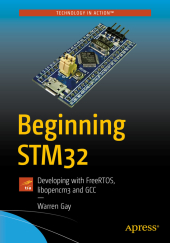 Neuerscheinungen 2018Stand: 2020-02-01 |
Schnellsuche
ISBN/Stichwort/Autor
|
Herderstraße 10
10625 Berlin
Tel.: 030 315 714 16
Fax 030 315 714 14
info@buchspektrum.de |

Warren Gay
Beginning STM32
Developing with FreeRTOS, libopencm3 and GCC
1st ed. 2018. xxi, 409 S. 69 SW-Abb. 254 mm
Verlag/Jahr: SPRINGER, BERLIN; APRESS 2018
ISBN: 1-484-23623-8 (1484236238)
Neue ISBN: 978-1-484-23623-9 (9781484236239)
Preis und Lieferzeit: Bitte klicken
Using FreeRTOS and libopencm3 instead of the Arduino software environment, this book will help you develop multi-tasking applications that go beyond Arduino norms. In addition to the usual peripherals found in the typical Arduino device, the STM32 device includes a USB controller, RTC (Real Time Clock), DMA (Direct Memory Access controller), CAN bus and more.
Each chapter contains clear explanations of the STM32 hardware capabilities to help get you started with the device, including GPIO and several other ST Microelectronics peripherals like USB and CAN bus controller. YouŽll learn how to download and set up the libopencm3 + FreeRTOS development environment, using GCC. With everything set up, youŽll leverage FreeRTOS to create tasks, queues, and mutexes. YouŽll also learn to work with the I2C bus to add GPIO using the PCF8574 chip. And how to create PWM output for RC control using hardware timers.
YouŽll be introduced to new concepts that are necessary to master the STM32, such as how to extend code with GCC overlays using an external Winbond W25Q32 flash chip. Your knowledge is tested at the end of each chapter with exercises. Upon completing this book, youŽll be ready to work with any of the devices in the STM32 family.
Beginning STM32 provides the professional, student, or hobbyist a way to learn about ARM without costing an arm!
What YouŽll Learn
Initialize and use the libopencm3 drivers and handle interrupts
Use DMA to drive a SPI based OLED displaying an analog meter
Read PWM from an RC control using hardware timers
Who This Book Is For
Experienced embedded engineers, students, hobbyists and makers wishing to explore the ARM architecture, going beyond Arduino limits.
Chapter 1 - Introduction Chapter 2 - Software Setup Chapter 3 - Power up and Blink Chapter 4 - GPIO Chapter 5 - FreeRTOS Chapter 6 - USART Chapter 7 - USB Serial Chapter 8 - SPI Flash Chapter 9 - Code Overlays Chapter 10 - Real Time Clock (RTC) Chapter 11 - I2C Chapter 12 - SPI OLED Chapter 13 - OLED Using DMA Chapter 14 - ADC Chapter 15 - Clock Tree Chapter 16 - PWM With Timer 2 Chapter 17 - PWM Input with Timer 4 Chapter 18 - CAN Bus Chapter 19 - CAN Bus Software Chapter 20 - New Projects Chapter 21 - Troubleshooting Chapter 22 - Appendix A - Answers to Exercises Chapter 23 - Appendix B
Warren Gay has been an electronics enthusiast since childhood and often dragged discarded TV sets home after school. In high school he learned to program the IBM-1130 and then pursued a career in software development at Ryerson Polytechnical, in Toronto. Since then he has worked professionally for over 30 years, mainly in C/C++, under Unix and Linux. Meanwhile, the love of electronics has never faded since the early creation of his home-brewed Intel 8008 system in the 70Žs to the present day projects employing the Raspberry Pi. Warren also holds an advanced amateur radio license and was able to work the Mir space station (U2MIR) using packet radio in August 1991. HeŽs authored other books including Sams Teach Yourself Linux in 24 Hours, Linux Socket Programming by Example, and Advanced Unix Programming.


